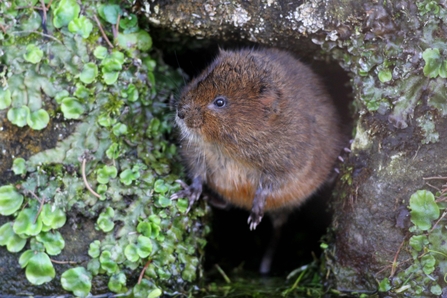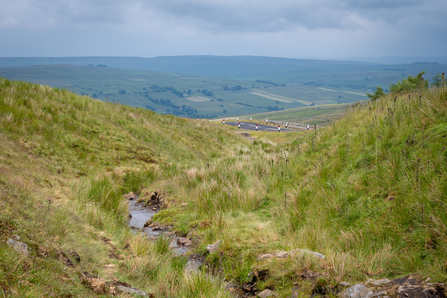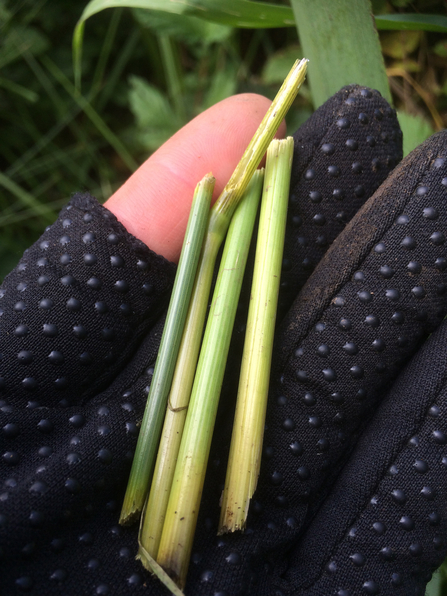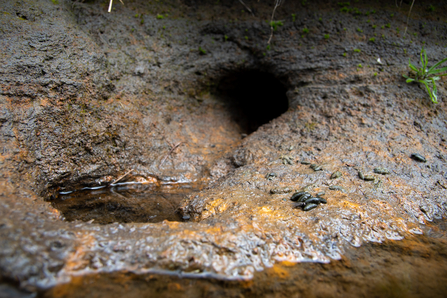
Water vole. Image by: Margaret Holland.

Water vole. Image by: Margaret Holland.
Water voles were once common across most of the British Isles, at the turn of the 20th Century their population was around 8 million. They were a common sight and sound in any slow flowing waterway and were considered by many as a species of languid lowland streams. Only in the past few decades have we begun to realise the importance of upland habitats for water voles.
The value of upland streams has been highlighted to an extent, by the dramatic decline of water voles from much of their lowland range. With over a 90% population decline since the 1900’s, some upland areas, such as the North Pennines, now hold a significant amount of the water vole population and may provide relatively safe havens.
You may ask, why have upland vole populations faired so much better than their lowland counterparts?
Throughout the 20th and 21st Centuries, our landscapes have undergone significant amounts of change, particularly through intensification of agriculture and built development. The result has been significant loss and degradation of water vole habitat, one of the main driving forces behind their decline. Much of this change has taken place in lowland areas and while not immune to these pressures, many upland areas have maintained well connected areas of suitable habitat.
Habitat fragmentation and degradation, also make water vole populations more vulnerable to the second main driving force behind their decline, the introduction of the American mink. From the 1950’s, this highly efficient non native invasive predator has made its way from fur farms into the wider landscape. With no effective defence strategy against this new threat, already depleted and fragmented water vole colonies are quickly wiped out.
Once again however, upland water vole populations appear to have been impacted less by American mink. This is likely for a couple of reasons. Firstly, it is thought that upland habitat is not ideal for mink and as such their numbers may naturally be lower. Also, the uplands have long been managed by gamekeepers and their trapping efforts are likely to pick up American mink moving into these areas and prevent significant populations being established.
Clearly not all upland habitat rivers, streams and ditches are suitable for water voles.
If you are a water vole you need a few key things; water all year round primarily as a means to evade predators, vegetation to eat, a place to hide usually a combination of dense bankside vegetation and a network of burrows and as we discussed in April's blog, "Reconnecting fragmented landscapes", well connected areas of suitable habitat.
This means that streams which run dry for parts of the year or become too shallow (typically less than 15cm deep), are not likely to be frequented. Other water courses which may be ideal in this respect, can become unsuitable due to over grazing, shading out by trees or poor ditch maintenance. There is a lot that land managers can do to help water voles thrive in the uplands. Grazing pressure can be managed to ensure there is enough vegetation along water courses, whilst preventing the growth of scrub. Existing trees and scrub along potential habitat can be thinned or removed and new woodland planting should be avoided within 10 meters of the watercourse. When cutting hay meadows, margins of at least 2 meters should be left along streams and ditches to ensure there is adequate food and cover and finally ditches should be maintained sympathetically, with the assumption water voles are present. The AONB have created detailed guidance on ditch maintenance which can be found here.

Langdon Beck Tributary. Image by: Elliot Lea
It’s great news that the uplands are providing a foothold for water voles but it is important we remain vigilant, as these populations are not immune from the threats which have wiped out many lowland populations. You can help by looking for water voles and their signs along suitable stretches of habitat and reporting your finding to emily.marshall@northwt.org.uk If you are lucky, you may spot a vole out and about feeding, or you may hear a “plop” as it dives into the water and swims away to safety. Although similar in size to a brown rat, you can identify a water vole by its blunter face, short rounded ears and shorter hairy tail.

Water vole feeding station. Image by: Elliot Lea
The most reliable way to know water voles are present is to look for their droppings, which will often be left in piles called latrines on rocks and features along the water's edge. These tic tac shape droppings are typically around 8-12mm long, 4.5mm thick, usually dark green although the colour can vary.
Also keep an eye out for burrows and footprints in the mud. Burrows entrances are roughly tennis ball size and are generally wider than they are tall and can be found at varying heights, from the bank top to blow water level. Footprints are similar to those of rats, with four toes on the front foot and five on the rear, but water vole prints are often described as star shaped, whereas rat toes are more forward facing. Rats also have longer heels than water voles. If in doubt take a photo with a coin for scale.
If you would like to learn more about identifying water voles and take part in our surveys, you can sign up to become a Naturally Native Water Vole Survey Volunteer.

Water vole burrow and latrine. Image by: Elliot Lea